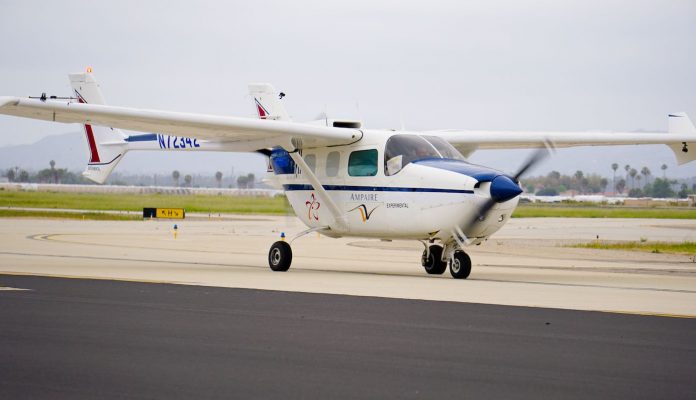
The Ampaire 337, or EEL – a hybrid-electric Cessna 337 retrofit. (Ampaire)
Just two weeks after Ampaire’s successful flight tests of its twin-engine hybrid-electric EEL commuter aircraft, Personal Airline Exchange (PAX) has placed an order for 50 of the retrofitted Cessna 337s, with an option for up to 50 more.
On June 6, Los Angeles-based Ampaire test-flew its prototype. Able to carry seven to nine passengers a range of up to 100 miles, it is the highest-capacity hybrid-electric ever to take off.
Ampaire describes its EEL, retrofitted with a proprietary electric propulsion system and lightweight battery, as “parallel hybrid,” using both the internal combustion engine and electric motor to optimize power output as the aircraft flies.
For PAX, a service that matches passengers with charter services at airports around the country, Ampaire’s EEL is an aircraft with lower fuel and maintenance costs and capabilities that fit its consumer profile.
“PAX modeled the types of flights that have highest value from a time savings and convenience perspective to our customers,” said PAX CEO Mike Azzarello in an email to Avionics. “As we looked at aircraft to fit the profile, the Electric EEL provides speed, passenger seats and range with lower operating costs compared to currently available aircraft.”
Azzarello believes Ampaire’s EEL — as a Cessna retrofit — will achieve certification quicker than new aircraft designs, and says a twin-engine plane is critical to success with customers.
“We have done surveys of travelers, very few are willing to get into a single engine aircraft consistently for business travel (regardless of powerplant), and almost all said they would not fly in an electric only aircraft as of today,” Azzarello said. “This makes the twin engine dual powerplant design of the EEL attractive to provide our customers with the sense of security of a twin powerplant and having a diesel engine.”

Photo: Ampaire
The reduction in cost achieved through Ampaire’s EEL is key to PAX’s business model, offering — as Azzarello puts it — “flights for trips that the airlines don’t make.”
“Ampaire modeled operating costs for an EEL and compared it to Cirrus SR22, Diamond DA62 and Pilatus PC-12,” he added. “The operating cost of the EEL is projected to be one-third to one-half of the operating costs of the other aircraft when measured as dollars/seat/hour.”
Azzarello believes the EEL allows PAX to reach a target customer price of $1 per seat per mile while using existing airport infrastructure.
“At that price point, PAX flights for regional trips become realistic alternatives to driving.”
Ampaire is targeting 2021 for certification for the EEL retrofit, which it also refers to as the Ampaire 337. The jet startup is also working on a concept it calls the TailWind, which will be available in both hybrid and electric versions.
PAX announced its intention to reserve up to the first 1,000 Ampaire TailWind electric jets produced.